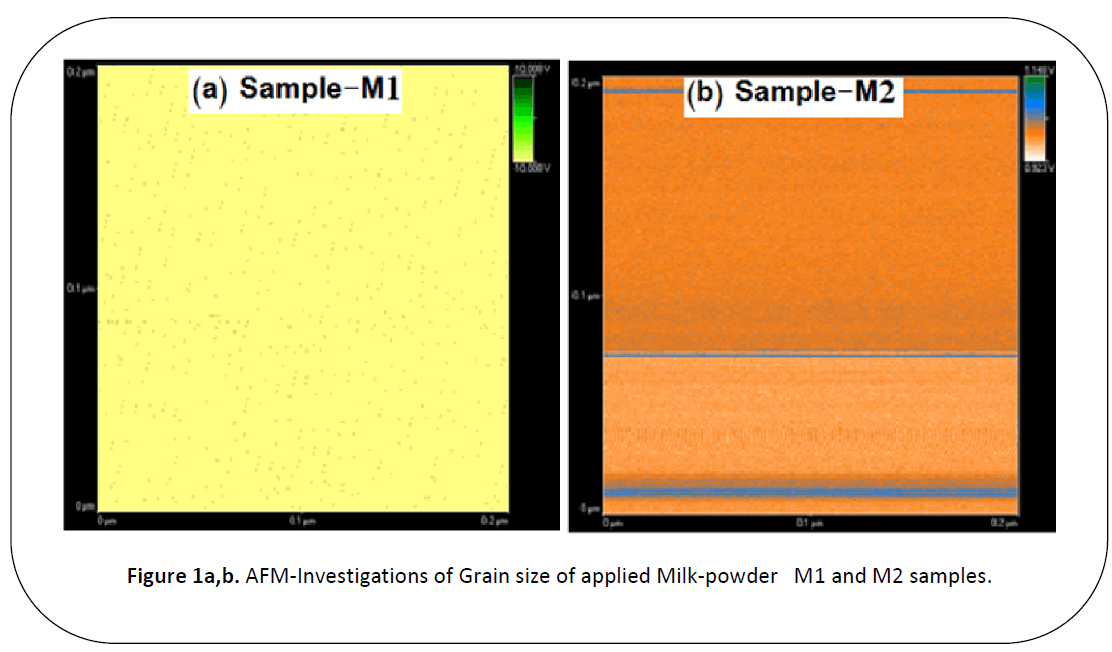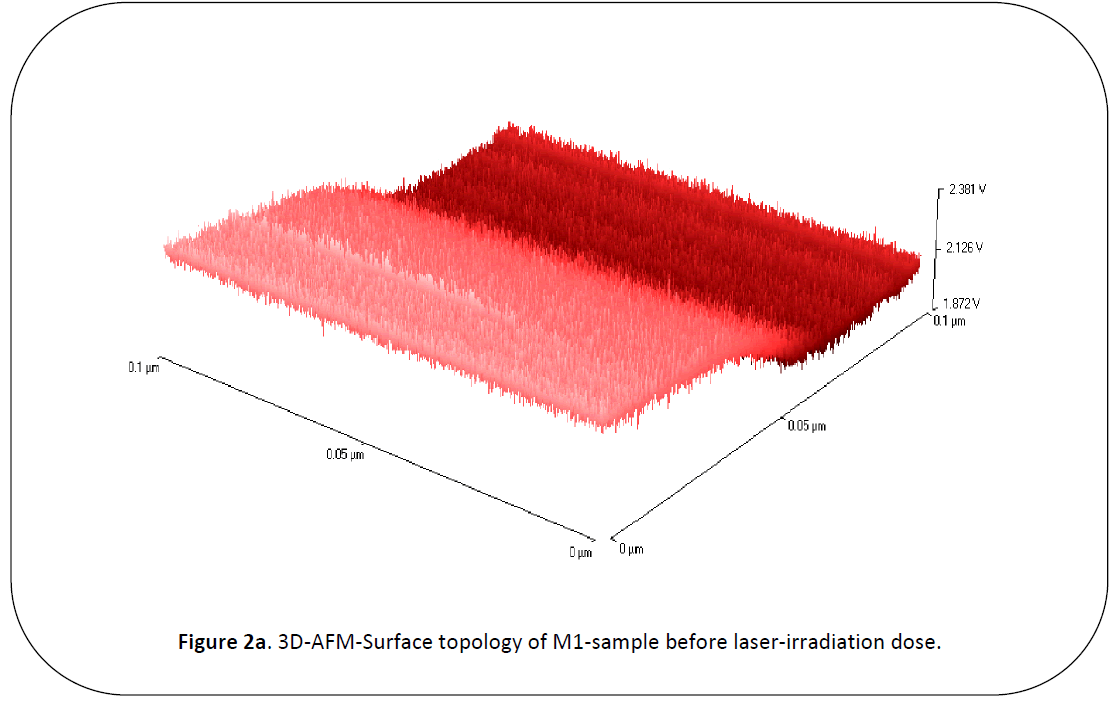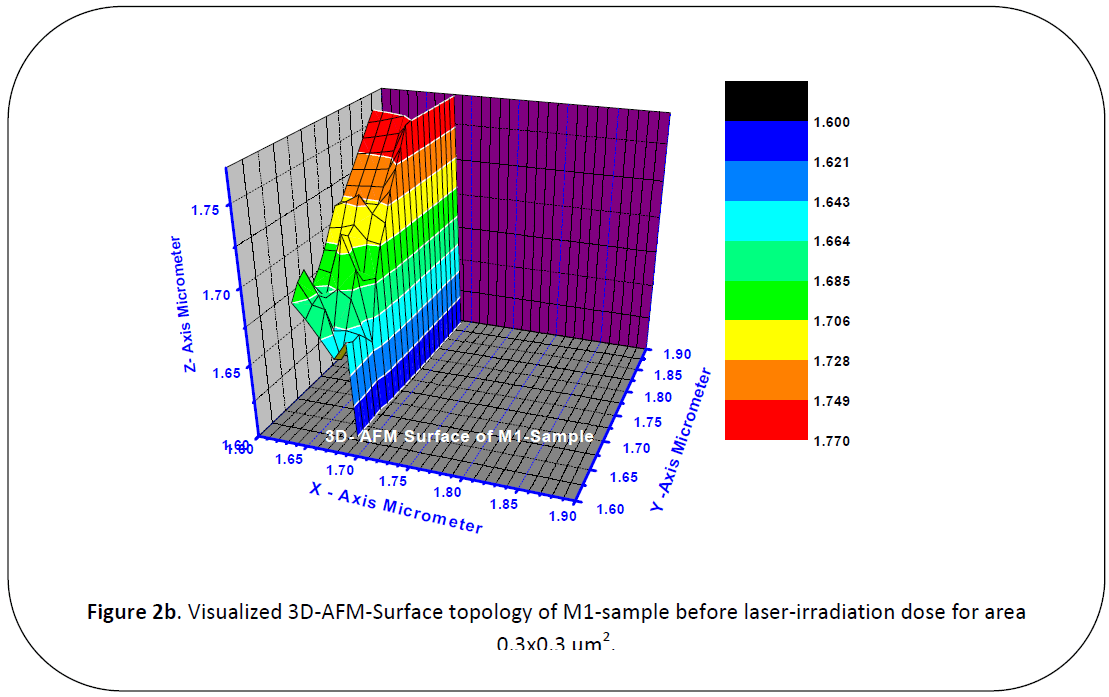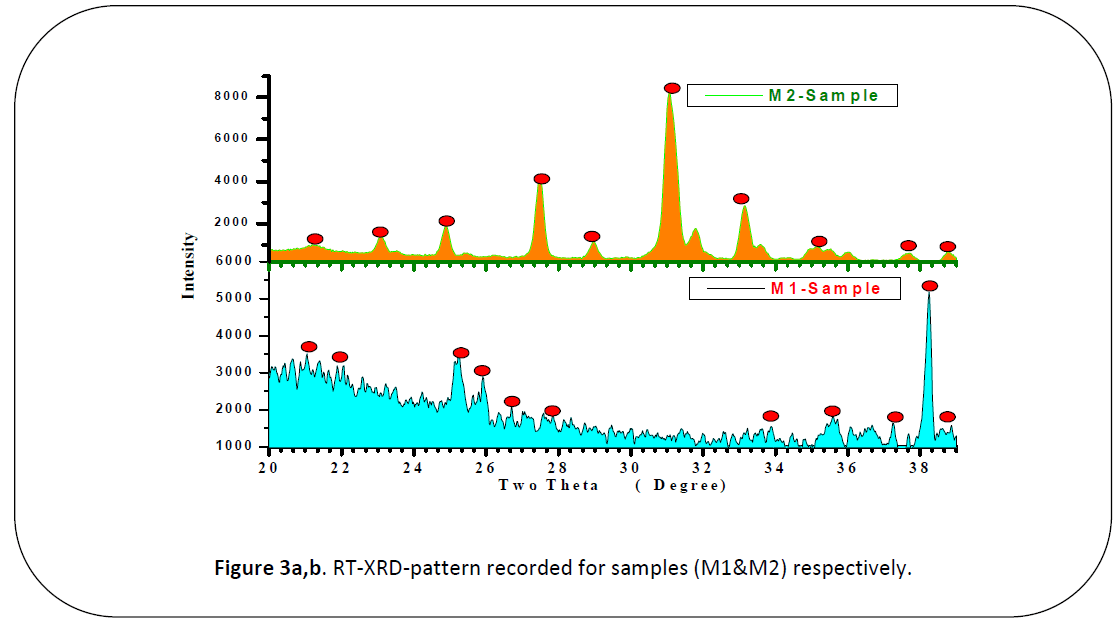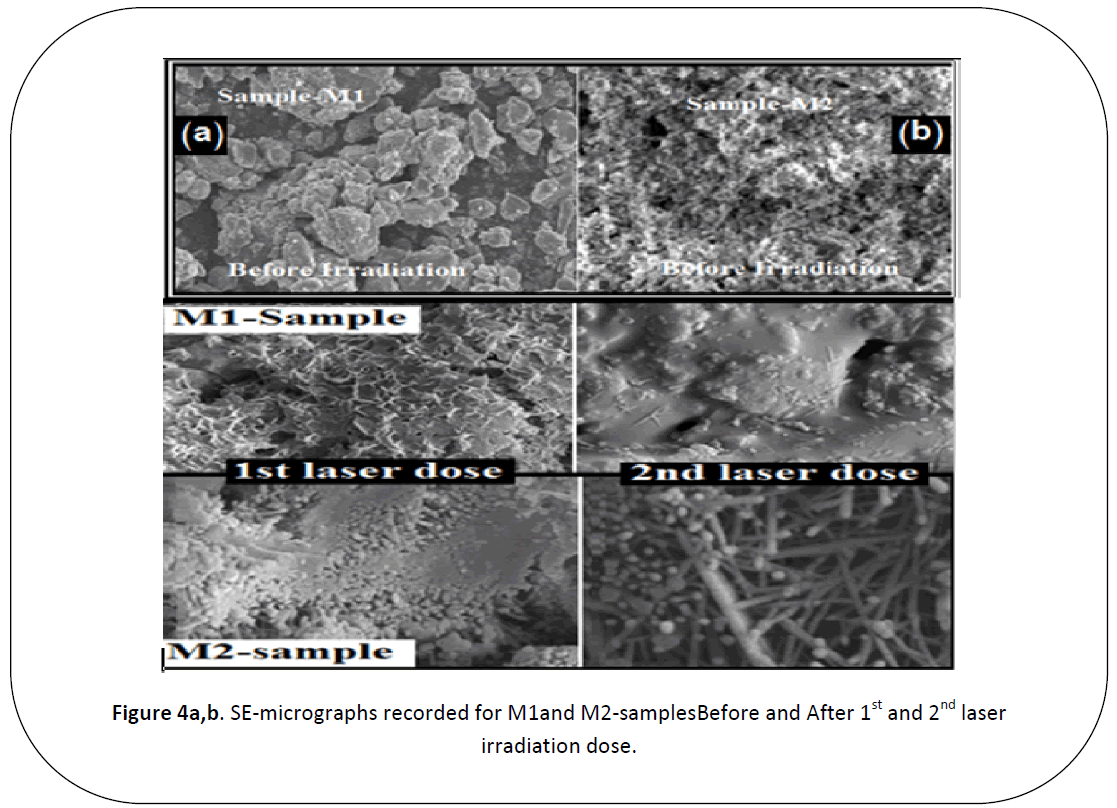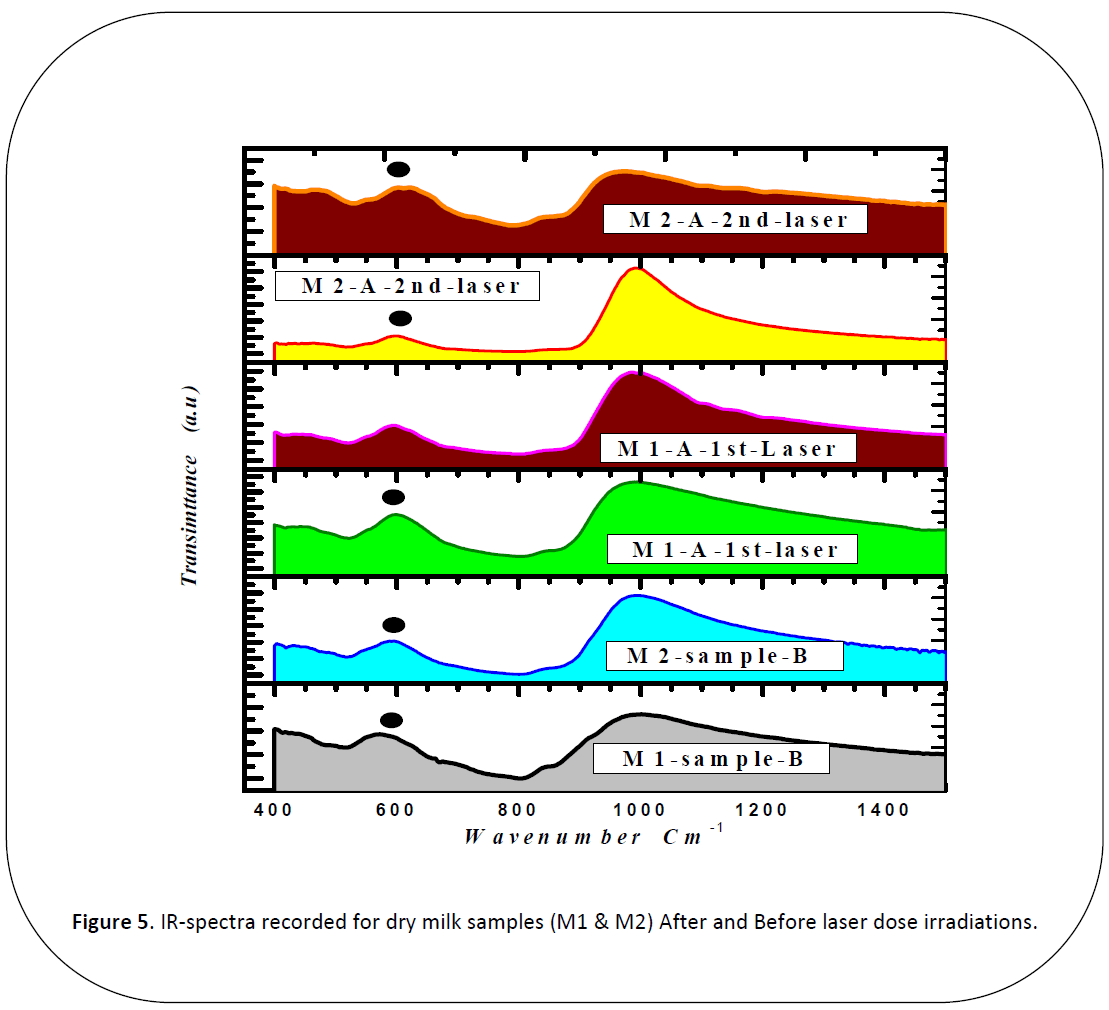Objective: the present studies discuss impact of two different kinds of irradiations ( high energy
Nd-Laser and Gamma – irradiations which has oxidative nature by additional to its thermal
effects) on the micro-structural parameters (grains ,particles sizes) of milk samples.
Methodology: the investigated samples will be examined spectrophotometrically and
structurally before and after radiations to confirm its internal structure features via (XRD,
microstructure) (SEM, AFM, Raman-Spectra) respectively. Also many of irradiation parameters
will be tested such as strength of irradiation dose and irradiation dosage time.
Results: XRD proved that the main crystal structure still as it is, AFM &SEM indicated that
huge changements on microstructure features were observed as function of irradiation dose
increase.
Conclusion: The results indicated that two applied irradiations sources have no impact on the
main crystallographic structure of applied sample only micro-structural features are changed.
Keywords
Nd-Laser; Gamma-ray; Grain Size; X-ray; SEM; AFM
Introduction
Irradiation sources [1-15] such as
Gamma rays, different kinds of Laser are
generally used for the sterilization of
gaseous, liquid, solid materials, different
kinds of systems . Gamma irradiation is not
only applied as clean tool of
decontamination, because it has killing effect to bacteria by damaging bacterial
DNA, inhibiting bacterial infections [16-30].
The gamma ray action involve photoninduced
mechanism incorporated with
changes at the cell level cause the death of
infected active micro-organisms. The
gamma irradiation process is clean and eco friendly technique due to it does not create
active residuals or any impart
radioactivity. [22-28].
The hazardous radiolytic active
products of water are mainly formulated by
indirect action on water molecules yielding
free radicals OH., e- aq and H. The action of
the hydroxyl radical (OH.) must be
responsible for an important part of the
indirect effects. Drying or freezing of living
organisms can reduce these indirect
effects [31-34]. Greez et al [31] have investigated
the action of radiation on bacteria and
viruses and effective use of optimized, high
dose (50kGy) gamma irradiation for
pathogen inactivation of human bone
allographs. They confirmed that sterilizing
by gamma irradiation is physical and
experimental condition dependent.
Many researchers have investigated
the different types of microorganism, mainly
bacteria and, less frequently, moulds and
yeasts, which found on many medical
devices and pharmaceuticals apparatus [35-44].
Many hypotheses have proposed and
tested regarding the mechanism of cell
damage by radiation. Some scientists
postulate the mechanism thought ‘radiotoxins’
that are the toxic moiety produced in
the irradiated cells responsible for lethal
effect. Others proposed that radiation was
directly damaging the cellular membranes
tissues . In addition, radiation effects on
enzymes or on energy metabolism were
postulated. The effect on the cytoplasmic
membrane appears to play an additional role
in some circumstances [45] .
Kaplan et al. [45] investigated the
effects of gamma irradiation of whole
chicken carcasses on bacterial loads and
fatty acids and contradict with some
hypotheses mentioned above .
The aim of the present investigations
are aiming to investigate the impact of two
different kinds of irradiations on the micro-structural features of solid phase milky
products.
Experimental
A. Samples preparation
Two different samples of dry milk
were selected to be the target of both Ndlaser
and gamma-Irradiation.
B. 1.Laser and Gamma-irradiation
sources
The applied laser Nd-pulsed laser
has the following parameters: wavelength λ
= 1.06 μm, pulsed rate ɳ = 10-3 s. The
targets were irradiated by two different
doses of Nd-laser beam irradiations the 1st
10 W/cm2 for 5 min., 2nd 20 W/cm2 for 10
min. The irradiation was carried out in air
without any external heating .The energies
of pulsed Nd-laser were sufficient to melt
homogeneously the surface and near surface
layers .SEM was used for monitoring the
morphological changements .After laserirradiation
doses all sample were irradiated
with gamma-ray 10 MR at distance =20 cm
using 137Cs as source for gamma-ray [46-48].
C. Phase Identification
The X-ray diffraction (XRD)
measurements were carried out at room
temperature on the fine ground samples
using Cu-Kα radiation source,Ni-filter and a
computerized STOE diffractometer/
Germany with two theta step scan
technique.
Scannig Electron Microscopy (SEM)
measurements were carried out at different
sectors in the prepared samples by using a
computerized SEM camera with elemental
analyzer unit (PHILIPS-XL 30 ESEM
/USA) .
Atomic force microscopy (AFM):
High-resolution Atomic Force microscopy
(AFM) is used for testing morphological
features and topological map (Veeco-di
Innova Model-2009-AFM-USA). The applied mode was tapping non-contacting
mode. For accurate mapping of the surface
topology AFM-raw data were forwarded to
the Origin-Lab version 6-USA program to
visualize more accurate three dimension
surface of the sample under investigation.
This process is new trend to get high
resolution 3D-mapped surface for very small
area ~ 0.1x0.1 μm2 [49,50].
D. FT-Infrared Spectroscopy
The infrared spectra of the solid
products obtained were recorded from KBr
discs using a Shimadzu FT-IR
Spectrophotometer in the range from 400 to
4000 cm-1.
Results and Discussion
Two different samples of dry milk
were selected to be the target of both Ndlaser
and gamma-Irradiation. The two
samples symbolized as M1 and M2
respectively. Many of spectral and structural
investigations of the samples (M1, M2)
under investigations were performed as
function of irradiation dose what ever it
Laser or Gamma-irradiations.
Figure 1a shows AFM-TM-deflection
centers which describes the distribution dots
represents pinning centers inside bulk of dry
milk sample that be responsible for
conduction inside bulk of material .The
estimated grain sizes were found in between
1.3-3.2 μm for sample M1 while 2.1-4.1 μm
is for M2-sample. Figure 1b display surface
topology of M2-sample with magnification
factor = 0.2 μm ,it was noticed that there are
two different levels of array parallel to each
other with average grain size in between 2.1-
4.1 μm which is relatively high in contrast
with grain size of sample-M1 due to
difference in solvent applied in extraction
process.
Figure 1: AFM-Investigations of Grain size of applied Milk-powder M1 and M2 samples.
Figures 2a,b describe real and visualized
3D-AFM-Surface topology of M1-sample
before laser-irradiation dose. The visualized investigations confirmed the results obtained
from AFM regarding averages of particle as
well as grain size. From Figure 2b it was
notified that the maximum heights were
ranged in between 1.86-1.90 μm (orange-red
zones) while minimum heights recorded
1.64-1.67 μm (black-blue zones).
Figure 2a: 3D-AFM-Surface topology of M1-sample before laser-irradiation dose.
Figure 2b: Visualized 3D-AFM-Surface topology of M1-sample before laser-irradiation dose for area 0.3x0.3 μm2.
Figure 3a,b displays fingerprint pattern
evaluated for dry milk samples M1,M2
respectively. Although the two dry milk
sample from two different factory the
internal lattice structure is fitted by ratio
higher than 60 % percent as clear in Figure 3a,b where red circle refer to fingerprint of
internal lattice structure which is mainly
lactose beside certain amount of lipids as
impurity phases .
Figure 3a, b: RT-XRD-pattern recorded for samples (M1&M2) respectively.
From Figure 4a,b one can notify that
the average grain size of sample M1 &M2
before irradiation was found in between 1-
4.5μm which is consistent with data
evaluated from AFM-investigation
mentioned before . But the topological
features of sample M1&M2 after 1st and 2nd laser irradiation dose are completely
different such the surface’s layers and near
surface layers reformed as small aggregated
zones with different grains shapes as clear in Figure 4b.
Figure 4a, b: SE-micrographs recorded for M1and M2-samplesBefore and After 1st and 2nd laser irradiation dose.
Figure 5 displays IR-spectra recorded
for dry milk samples (M1 & M2) after and
before laser dose irradiations .It was
observed that dry milk samples (M1,M2)
still having the function groups even after
2nd irradiation Nd-laser dose as clear in Figure 5. The black circles refer to broad
characteristic peak for applied milk sample
and no remarkable differences as laser dose
increase .These results support the opinion
that declare that applied Nd-laser irradiation
dose within the save limits in which crystal
structure of milk does not changed as proved
in our X-ray measurements.
Figure 5: IR-spectra recorded for dry milk samples (M1 & M2) After and Before laser dose irradiations.
Conclusions
The conclusive remarks inside this
article can be summarized in the following
points;
1- Applied irradiation doses have negligible
effect on structure phase.
2- Grains and particles sizes enlarged as
irradiation dose increase.
3- Micro-structural properties are sensitive
to irradiation.
References
- Alariqi SA, Rao AK, Singh RP, Biodegradation of Gamma-sterilised biomedical polyolefins under composting and fungal culture environments. Polymer Degradation Stability, 2006, 91, 6: 1105–1116.
- Ká tia Aparecida da Silva Aquino. Sterilization by Gamma Irradiation, Gamma Radiation, Prof. Feriz Adrovic (Ed.), 2012, ISBN: 978-953-51-0316-5, In Tech, Available from: https://www. intechopen.com/books/gammaradiation/s terilization-by-gamma-irradiation.
- Action biologique et chimique des rayonnements ionisants (ABCRI). B.Tilquin(Ed.) Paris, France,2001:p.115.
- Alkahtani HA ,Abutarboush MH, Bajaber AS , Atia MM, Abouarab AA, Chemical changes after irradiation and post-irradiation, storage in Tilapia and Spanish mackerel. Journal of Food Science, 1996, 61: 729-733.
- American Society for Testing and Materials. Standard Guide for Selection and Calibration of Dosimetry Systems for Radiation Processing, ISO/ASTM 51261, Annual Book of ASTM Standards, ASTM, 2006:970–988, NewYork, USA.
- Freitag GD, Mueller UP, Polycarbonates. In: Encyclopedia of Polymer Science and Engineering, Vol. 11, 2nd ed, 1988:648-718, New York,Wiley-USA.
- Aquino KS, Araujo ES, Effects of a Hindered Amine Stabilizer (HAS) on Radiolytic and Thermal Stability of Poly(methyl methacrylate). Journal of Applied Polymer Science, 2008,110, 1: 401-401.
- Aquin KS, Araujo ES, Guedes SM , Influence of a Hindered Amine Stabilizer on optical and mechanical properties of poly (methyl methacrylate) exposed to gamma irradiation. Journal of Applied Polymer Science, 2010,116,2:748-753.
- Araujo ES, Khoury HJ, Silveira SV, Effects of gamma-irradiation on some properties of durolon polycarbonate. Radiation Physics and Chemistry, 1998,53:79-84.
- Armstrong SG, Wyllie SG, Leach DH,Effects of preservation by gamma irradiation on the nutritional quality of Australian fish, Food Chemistry, 1994,50:351-357.
- Baccaro SS, Brunella V, Cecclia A, Costa L, Gamma- irradiation of poly(vinyl choride) for medical applications. Nuclear Instruments and Methods in Phys.Res., 2003, 208:195- 198.
- Brewer MS, Irradiation effects on meat flavor: A review. Meat Science, 2009, 81: 1-14.
- Billen, D. The role of hydroxyl radical scavengers in preventing DNA strand breaks induced by X irradiation of toluene treated E. coli. Radiation Research, 1984,97: 626-629.
- Borrely SI, Cruz AC, DelMastro NL, Sampa MH, Somessari ES, Radiation processing of sewage and sudge. A review. Progress in Nuclear Energy, 1998,33: 3-21.
- Broomfield S, Hryciw TC , Xiao W, DNA postreplication repair and mutagenesis in Saccharomyces cerevisiae. Mutation Research,2001, 486: 167-184.
- Cadet J, Douki T, Gasparutto D,Gromova M,Pouger JP, Ravanat, JL, Romieu A, Sauvaigo SD, Radiationinduced damage to DNA: mechanistic aspects and measurement of base lesions. Nuclear Instruments and Methods. in Physics Res.section B,1999, 151: 1-7.
- Campbell DG, Li P, Sterilization of HIV with irradiation: relevance to HIV infected bone allografts. NZ Journal of Surgery, 1999,69: 517-521.
- Coates ME, Ford JE, Gregory, ME, Thompson SY, Effects of gammairradiation on the vitamin content of diets for laboratory animals. Laboratory (1969).
- Crucq AS, Slegers CC, Deridder V, Tilquin NB, Radiosensitivity study of cefazolin sodium. Talanta, 2000, 52: 873-877.
- Daar ES, Moudgil T, Meyer RD, , Transient levels of viremia in patients in primary human immunodeficiency virus type 1 infection. New England Journal of Medicine. 1991,324: 961– 964.
- Daly MJ, Gaidamakova EK, Matrosova VY, Vasilenko A, Zhai, MM, Leapman RD, Lai, B, Ravel BW, Kemner KM, Fredrickson JK, Protein oxidation implicated as the primary determinant of bacterial radioresistance. PLOS Biology, 2007, 5: 769-779.
- Diehl JH, (1967). Combined effects of irradiation, storage, and cooking on the vitamin Eand B1 levels of foods. Food Irradiation,1967, 10: 2-7.
- Farkas J, Farkas CM. , History and future of food irradiation, Trends Food Science & Technology, 2011,22:121- 126.
- Fox, JB, Lakritz KL, Thayer DW, Thiamin, riboflavin and γ -tocopherol retention in processed and stored irradiated pork. Journal of Food Science,1997, 62, 5:1022-1025.
- Fox JB, Lakritz L, Hampson J, Richardson F, Ward K ,Thayer DW,Gamma irradiation effects on thiamin and riboflavin in beef, lamb, pork, and turkey. Journal of Food Science,1995, 60, 3:596-598.
- Geis, PA., Szaniszlo PJ, Carotenoid pigments of the dermatiaceous fungus Wangiella dermatitidis. Mycologia, 1984,76: 268-273.
- Goldman MN, Gronsky, RC ,Pruitt, LL, The influence of sterilization technique and ageing on the structure and morphology of medical-grade ultrahigh molecular weight polyethylene. Journal of Materials in Medicine,1998, 9:207- 212.
- Gonzalez, M E. & Docters, A. S. Evaluation of stability of polymeric insulation materials in radiation fields and development of radiation stable PVC and polypropylene for medical devices, In: Stability and stabilization of polymers under irradiation, IAEA tecdoc- 1062 (Ed), 97-110, Vienna, Austria (1999).
- Guillet LJ, Polymer photophysics and photochemistry, Cambridge University Press, New York, USA,(1985).
- Grecz N, Snyder OP, Walker AA, Anellis A, temperature of liquid nitrogen on radiation resistance of spores of Clostridium botulinum. Applied Microbiology,1965,13:527–536.
- Almeida JT, Bogdansky SS, Ronholdt CR, Drohan, WN & Burgess, WH , Effective use of optimized, high dose (50kGy) gamma irradiation for pathogen inactivation of human bone allographs. Biomaterials,1983, 26: 2033- 2042.
- Hafez YS, Mohamed AI, Singh, G, Hewedy FM, Effects of gamma irradiaton on proteins and fatty acids of soybean. Journal of Food Science,1985, 50: 1271- 1274.
- Hansen MT, Multiplicity of genome equivalents in the radiation-resistant bacterium Micrococcus radiodurans. J. of Bacteriology,1978, 134: 71-75.
- Hau LB, Liew, MS, Effects of gamma irradiation and cooking on vitamin B6 and B12 in grass prawns (Penaeus monodon). Radiation Physics and Chemistry,1993, 42:297-300.
- Helfinstine SL. Vargas-Aburto C, Uribe RM, Woolverton CJ, Inactivation of Bacillus endospores in envelopes by electron beam irradiation. Applied and Environmental Microbiology, ,2005,71: 7029-7032.
- Hernigou, P. Gras, G. Marinello, G. & Dormont, D. Influence of irradiation on the risk of transmission of HIV in bone grafts obtained from appropriately screened donors and followed by radiation sterilization, Cell Tissue Bank, 2000,1 4: 279–289.
- Hiemstra MH, Tersmette MV, Ove AH, Van Berkel, MP, Bree, H, Inactivation of HIV by gamma radiation and its effect on plasma and coagulationfactors, Transfusion,1991, 31, 1: 32–39.
- International Atomic Energy Agency (IAEA). International standards for tissue banks, AEA, Vienna, Austria(2004).
- International Atomic Energy Agency (IAEA). Radiation for a clean environment, Proceedings of International Symposium on the use of high-level radiation in wastetreatment, Munich, Germany, March17-21, (1975).
- International Organization for Standardization. Sterilization of healthcare products –Requirements for validation and routine control— Radiation sterilization, ISO 11137, ISO, Geneva, Switzerland,(2006).
- International Organization for Standardization. Sterilization of Health Care Products —Radiation — Part 1: Requirements for the Development, Validation and Routine Control of a Sterilization Process for Medical Products, ISO 11137-1, ISO, Geneva, Switzerland,(2006).
- International Organization for Standardization. Sterilization of Health Care Products —Radiation — Part 2: Establishing the Sterilization Dose, ISO 11137-2, ISO, Geneva,Switzerland, (2006).
- International Organization for Standardization. Sterilization of Health Care Products —Radiation — Part 3: Guidance on Dosimetric Aspects, ISO 11137-3, ISO, Geneva, Switzerland (2006).
- International Organization for Standardization. Sterilization of Medical Devices –General Requirements for Characterization of a Sterilizing Agent and the Development, Validation and Routine Control of a Sterilization Process for Medical Devices, ISO- 14937(E), ISO, Geneva, Switzerland, (2000).
- Kaplan IB. Nuclear Physics. Addison- Wesley Pub. Co., Boston, USA, Katta SR, Rao DR, Sunki GR, Chawan CB. (1991). Effects of gamma irradiation of whole chicken carcasses on bacterial loads and fatty acids. Journal of food science,1955,56: 371-372.
- Elsabawy KM, Elnewehy MH , Pulsed- Nd-Laser Irradiations Effects on Structural and Micro-structural Features of Optimally Lutetium Thorium-Codoped Free Lead- 2212-BSCCO“, Applied Surface Science, 2011,258: 1345-1352 .
- Elsabawy KM, Elhawary WF, Mohsen Q , Youssef MM, "Gamma-Irradiations Effects on Structural and Micro- Structural Parameters of Water Remediator HP- Mica- Cr-III-Clay Synthesized in Organic Solvent", Materials Science Journal, 2009, 5,4:1- 7.
- Elsabawy KM ,Abousekkina MM,Two dimensional γ–irradiation for promoted structural properties of MgB2 superconductors, Physica C, 2002, 377:411-415.
- Elsabawy KM, „Synthesis of Tunable MgB2/Nano-Graphene/MgB2–Josephson Junction Like Structure for Electronic Devices“, SC-Advances Journal ,Royal Society of Chemistry, Cambridge –UK, 2011,1:.964-967 .
- Elsabawy KM, Elmaghraby AA, :“ AFM- Investigations, Structural Visualization Studies, and Temperature Optimization of Single Metal Cyclotetraphosphates Synthesized at Elevated Temperature, Eur. Chem. Bull , 2012,1(6):223-231.

